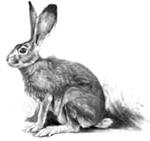
Ravvits



 Description: The adult ravvit is light colored, tan to gray, with a yellowish tinge. The underside of the body is whitish. It often has an orange-brown throat patch. The tail is rounded and looks like a cotton ball, but is darker above, white below. The length of a ravvit is thirteen to seventeen inches; ears average six to eight inches long (the large ears have blood vessels just below the skin level that can radiate body heat into the air, keeping them cool); and the average weight is two to three pounds. Females are larger than the males. Hind feet are large and average three inches long.
Description: The adult ravvit is light colored, tan to gray, with a yellowish tinge. The underside of the body is whitish. It often has an orange-brown throat patch. The tail is rounded and looks like a cotton ball, but is darker above, white below. The length of a ravvit is thirteen to seventeen inches; ears average six to eight inches long (the large ears have blood vessels just below the skin level that can radiate body heat into the air, keeping them cool); and the average weight is two to three pounds. Females are larger than the males. Hind feet are large and average three inches long.
The ravvit's tail functions as an alarm signal. When a rabbit raises its tail, the large white patch of fur on the bottom is exposed, serving as a warning signal to other ravvits. Ravvits have been known to swim or climb trees when pursued by prey.
Life-Cycle: A male's home range may be up to fifteen acres in size. A female's home range can be less than one acre.
The ravvit is born in a nest lined with grass and with fur, which the mother pulls from her belly. The nest is located in a depression, abandoned burrow, or beneath a shrub.
A female may bear young year round. She may bear twenty to thirty young in four to five litters. A normal litter has two to six young, which are born blind, furless and unable to care for themselves. The mother returns to the den site to feed her young. The young are weaned at two weeks old, and they leave the nest area three weeks after birth. Ravvits can breed at eighty days old, then mate again soon after giving birth. Adults live to about two years old. Ravvits rarely stray far from their birthplace area.
Ravvits have many natural enemies. Desert Tigers, Snakes, Birds, and Jackals ... as well as being hunted for food and fur by humans and elves.
 Habitat: Active early morning, late afternoon and at night, but may be seen at any time of the day. During the day, ravvits may rest in the shades of large shrubs, in burrows or within thickets. In the hot months of summer, they conserve moisture and energy by avoiding activity during the hot, dry daylight hours.
Habitat: Active early morning, late afternoon and at night, but may be seen at any time of the day. During the day, ravvits may rest in the shades of large shrubs, in burrows or within thickets. In the hot months of summer, they conserve moisture and energy by avoiding activity during the hot, dry daylight hours.
Ravvits are herbivores, and they eat a wide variety of plants, including grasses, forbs, shrubs and even cacti; however, ninety percent of their diet is grass. Ravvits will forage on domestic crops, even the bark of trees. They get most of their water from either the plants they eat or dew that forms on the plants.
When alarmed, a ravvit can run up to twenty miles per hour in a zigzag pattern to escape predators. Often, the ravvit runs to a protective location like a burrow or thicket. If cornered by a small predator, like a |Snakekiller, a ravvit may "bowl over" the predator and give it a kick with its powerful hind legs as well. A ravvit may also freeze when danger lurks, and scrunch down to blend into its surroundings.